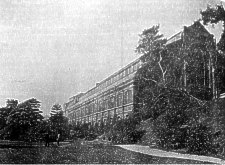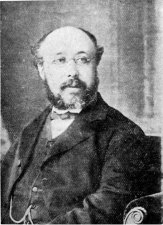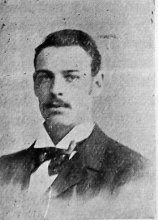
The Palace: The main building
[From The Tourist Vol 1 p74/78 - 1897]
Those prevailing motives of those who, at the present time, go for short holidays,
is to select places where amusements can be found in addition to the fresh air
and fine scenery, which, of course, are universally demanded. In the days of
our forefathers a sea beach and a bathing van were sufficient; to-day the tourist
requires thousands spending on the beautification of a mere entrance, in order
that the purchasing power of his shilling may be enjoyed amidst artistic surroundings.
With anything paltry the holiday traveller has a significant contempt, for he
has become highly critical, making known his opinions by storming the early
doors of places he regards with approval, and by carefully staying away from
those which fail to comply with his exacting mind.
It occurred to the writer that a pictorial description of a typical home of entertainment would be interesting, and after running over those of some half-dozen watering places, came to the conclusion that the Palace, at Douglas. To the Palace, therefore, he betook himself.
To begin with, what is a Palace? Any lexicon will say it is "a residence of king, prince, or other great personage," and therefore I am bound to include tourists in the latter category. Still in the strictest sense, this Palace - new as it is - has a sort of kingly residential history.. It forms part of the Castle Mona estate, and Castle Mona was built - its grey stones coming all the way from the Isle; of Arran -by the Duke of Athol, "a King of Mann," at a cost of about £35,000, the Athol and the insular arms being engraved on the front of its square, solid pile Naturally in a residence of this character the grounds were a notable attraction, and, although I descriptively mention these later on, I will here remark that they are maintained in all their early beauty at the present time. In short, Castle Mona is as fine as ever it was, but instead of yielding pleasure to a single person, now gives it with liberal hand to thousands. This began so far back as 1831 when the Castle first became an hotel; the old furniture and internals were retained, and, as mentioned, also the grounds. Years rolled on, and the outer fringes of the estate were sold; when finally it occurred to Mr. J. A. Brown, a gentleman widely known throughout the Island and also in England as possessing a remarkably sound judgment and one whose mere association with at undertaking gave it a prescriptive guarantee Of success, that the most famous part of the grounds - that immediately adjoining the Castle-offered a really admirable site for the erection of the Palace I am about to describe. No one can deny this, but still the genius lay in thinking of it the earliest. With Mr. Brown, it appears to me, to think is to act, and he soon had round him suitable associates, and the acquisition of so noble a spot in the very middle of Douglas Bay was gained.
What then must be put upon it? If I say that the tall and elegant buildings now there are the sole product of the brains of the Mr. Ernest Long, the chief, and Mr. Edward Forrest, the subsidiary architect, I should wrong Mr. Brown, and yet if I said it was he, I should wrong them. It was, I am fully certain, happily devised by the artistic skill of the one, and the business brilliancy of the other.
There are some places to which the photographer's camera never could do justice, and never will. the Palace is one of them. As a whole it is unsurpassed, for, good as any portion is, there needs the influence of one section on another to worthily complete all; yet the views I have decided to give are not only the result of Mr. Bruton's experience, but Mr. Holland first of Manx artists - being on the spot advised and confirmed them. The picture of the main building shows its lofty outward extent: this is, of course (I mean the interior) the main saloon, and in it thousands can be simultaneously amused, whether by dancing, on a week-day ; at a Sunday concert, or by the elaborate orchestra there usually maintained.
I fear I have but small claim to be a judge of floors, but the one at the Palace appears to me to carry the mechanics of carpentry to a fine art. On its 200 ft. by 80 ft. of solid English oak I believe countless thousands have enjoyed themselves, aided, be, it, first remarked, by the music of Mr. Eyton's renowned band. Furthermore, it is a room so unique in the Island as to be used for the National Guild, and many other special purposes besides. There is no room like it, in fact; a tribute, look at it how you will, to Mr. Brown and his associates' foresight.
 Mr. J. A. Brown Chairman of the Palce Co. |
 Mr. Charles Fox, junr |
I took care to ask Mr. Charles Fox, junr., the manager for five successive years of distinguished prosperity, a few questions, and was astounded to learn that on Sunday, Aug. 11th, 1895, on the occasion of a Sacred Concert (Sims Reeves, Madam Belle Cole, and Miss Maggie Davies sang on the occasion) nearly seven thousand persons were present. It seems past belief, but there was room for all! The success of the Palace Sunday Concerts has been amazing ; indeed, I think, unequalled. Certainly the singers have been entirely of the first class, and the surprise itself of finding them so remote from London was alone a vast attraction. Why? because dwellers from all quarters, temporarily at the sea-side, could, probably for the first time, hear them. Here are the names of some who have sung :-Madame Albani (she is coming again this summer), Madame. Trebelli, Madame Belle Cole, Miss Clara Butt, Madame dice Goinez, Miss Esther Palliser, Miss Marion Mackenzie, Miss Maggie Davies-and of male voices? the incomparable trio of their period, Santley, Edward Lloyd, and Sims Reeves.
Could a tourist, on a summer sojourn, ask for more?
But this Palace of Delight - I think I could hardly bestow a better title on it - has another strong card up its sleeve for one's entertainment. Below the splendid room shewn in my picture is a smaller one, comfortably compact, nicely side boxed and pitted, and (of course excluding the stage)surrounded by an artistic gallery. They call this the Opera House. It is the house of fun. Visitors scarcely bother looking over the bill - they know that when they get a seat they are sure to laugh. They appear to rely completely on the executive for strong " talent," I think they call it, and not indeed to have embarked their faith in vain, when one remembers the "stars " who have shone there. At one time or other mostly still the leaders have appeared. To give their names would be wearisome. Vesta Victoria, Billie Balow, Maggie Duggan, Constance Moxon - Lester Barrett, G. W. Hunter, Dutch Daly ; indeed "all the cracks," as the sporting papers say.
A philosopher has put it that no sight is better than seeing people laugh till their sides ache. I have seen them do it at the Palace, and I have felt sorry that within a week they are bound to go home and work again. Questioned, they regard this laugh as setting them up for a twelvemonth.
It never struck me that way, but there's something in it. Possibly you could laugh anywhere, but certain surroundings seem to encourage entertainlment ; the Palace is one of them.
Suppose one imagies an entrance on a summer's night ! From the vast grandeur of the frontal promenade at Douglas- of itself an unmatched scene - a quick turn under the sombre glory of Castle Mona, and at a step beneath the fairy lights of the Palace ! There are twentyfive arc lamps, and one thousand incandescents ! To the right the lovely glassed archway - it is shewn in another of the photographs - to the left the ancient gardens, still clothed in their highest beauty! Between the Great Hall and the Opera House a decorative canopy, brilliant of decoration and glass, and dazzling with the lamps!
 Visitors enjoying themselves |
 The grounds behind the palace |
Behind, is the entrance to the rearmost grounds, a sylvan portion set apart for such fantastic sports as are populart' at the moment. Naturally they vary with the seasons, and with the progress of human invention. But my photos here again are typical specimens and especially of the fine full-leafed trees which cordon this more rustic section.
Thus there are three portions ; the immense hall with its circular
starge in the centre of its western side, with its oaken floor, the largest
unbroken dancing area in Great Britain (by the way it is not in Great Britain
at all, but in the Ancient Kingdom of Mann, though no matter)-with its ornamented
galleries, and its tuneful band. The smaller house, with its cozy look, its
bright stage, and its funny singers. The
back portion with its ancestral trees, and its scientific joys.
 The Palace: inside the entrance gates |
 The grounds looking North |
And yet there is another side to all, which struck ine with immense
force. I have seen Douglas thronged from end to end. I have felt the sea breeze
scarcely strong enough) to dissipate the heat. I have seen every seat on the
promenade occupied, and every tram car full. I have seen the frontal steps of
everv boarding house peopled with heated mortals. And in the midst of all this,
though few of them know it, was, a cool park - it might have been a corner from
Chatsworth or Fountans Abbey - where huge trees overhang velvety grass; where
roses, pansies, geraniums, and marguerites lend the touch and tone of colour;
where the fuchsia and the escalonia grow in sheltered strength ; where even
the grand modern building is half covered with climbing hop and ivy. I say I
have stepped into this restful park, astonished how little its beauties were
knownn without, and bewildered by its contiguity to the hot, busy scene of holiday
making but few yards away. No wonder the holiday maker likes the Palace, and
nightly throngs its gates ; he well knows, as I do, that no other home of entertaitnnent
gives him the trio of choice which I have endeavoured to point out.
T. E. E.
|
|
||
|
|
||
|
Any comments, errors or omissions gratefully received The
Editor |
||